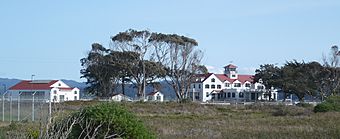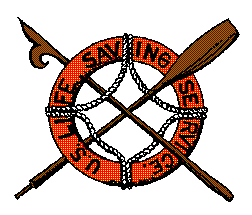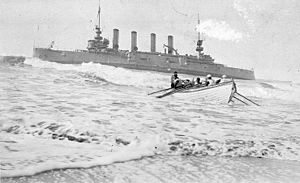Humboldt Bay Life-Saving Station facts for kids
Quick facts for kids |
|
|
Humboldt Bay Life-Saving Station
|
|

The Humboldt Bay Life-saving Station
|
|
| Nearest city | Eureka, California |
|---|---|
| Area | 46.5 acres (18.8 ha) |
| Built | 1936 |
| Built by | Fred J. Maurer |
| Architectural style | Eastern seacoast |
| NRHP reference No. | 79000477 |
| Added to NRHP | October 30, 1979 |
The Humboldt Bay Life-Saving Station is a historic building in northern California. It was first built in 1878 near Eureka, right by the entrance to Humboldt Bay. This station was created to help ships and people in trouble at sea. It was rebuilt in 1936 with special ramps called marine railways to launch rescue boats quickly. Today, it is still an important part of the United States Coast Guard operations in the area. The station was added to the National Register of Historic Places in 1979.
Contents
Saving Lives at Humboldt Bay
A Dangerous Bay for Ships
Humboldt Bay was known as one of California's most dangerous harbor entrances. It had a narrow channel, strong tidal currents, and shifting sandbars. The weather was also tricky, with high winds and thick fog.
To help guide ships, the United States Congress funded the Humboldt Harbor Light in 1851. This lighthouse started working in 1856. It had a 53-foot tall tower with a light powered by vegetable oil. The lighthouse was damaged by earthquakes and a flood over the years. Because fog often hid its light, it was moved in 1892 to a new location called Table Bluff Light. Years later, the top of the old tower was found and moved to the Humboldt Bay Maritime Museum.
Other navigation aids, like bells on boats and fog whistles, were also used by 1908. These helped ships find their way in the fog.
The First Life-Saving Station
In 1878, the United States Life-Saving Service was created. They built stations only where sea conditions were very dangerous. The Humboldt Bay station was the second one built in California. It opened in November 1878. Its job was to rescue ships and people from wrecks and patrol the beaches.
The station had a keeper and six volunteers. Later, "surfmen" were hired. They lived at the station, which could also house people they rescued. After the old lighthouse closed in 1892, the surfmen used its tower as a lookout. A telephone was installed in 1901 to help with rescue work. In 1910, the station started using its first power-driven boat for rescues, though hand-rowed boats were still used.
The New Station of 1936
In 1936, as part of a national upgrade during the New Deal era, a new Humboldt Bay Station was built. The plans were drawn in February 1936, and the building was ready by January 1937. It cost $78,000 to build. Chief Garner Churchill led the station from 1937 until 1966. During his time, the station saved over 300 people.
The new station could house and feed a crew of 25. It also had living quarters for the Chief and his family. Two special ramps, called marine railways, were built. These ramps allowed rescue boats to be launched quickly into the water. They also made it easy to pull boats, sometimes full of rescued people, out of the water.
During Prohibition, the station helped stop illegal alcohol smuggling. In December 1941, a Japanese submarine attacked a ship offshore. After this, the station's crew patrolled the coast on foot and horseback. During World War II, a Navy seaplane base and Blimp facility were built nearby. After the war, the blimp station became part of the Eureka Municipal Airport. You can still see the circular blimp pads in aerial photos today.
Amazing Rescues
Between 1850 and 1878, nearly two dozen ships were wrecked near the mouth of Humboldt Bay. The Life-Saving Station played a huge role in many rescues:
- In 1906, the Passenger Steamer Corona was in trouble. All 96 passengers and 60 crew members were saved, though two surfmen were lost.
- The U.S. Navy submarine H-3 got stuck offshore in December 1916. It had 27 crew members and live torpedoes. A local company later rolled the submarine over sand dunes and back into the water using giant logs.
- The U.S.S. Milwaukee was sent to help the H-3 but also got stranded in January 1917. The station helped save 421 enlisted sailors and 17 officers from the Milwaukee.
- The Yacht Rena sank in June 1939. Four people were saved, and the Chief and his crew received the Silver Medal for their brave rescue. This is the second highest award for lifesaving.
- The Brookley, the Tiverton, and the Yellowstone were three schooners that got stranded. All their passengers were saved thanks to the station.
Station Buildings and Marine Railways
The Humboldt Bay Life-Saving Station is important for its role in navigation and saving lives. It is a great example of the 'Roosevelt Style' of Colonial Revival station design. This style was used across the country from the late 1920s to the late 1940s.
The Station has two 274-foot long marine railways. These ramps go from the station's doors down into the water, even below the low tide line. They were used to launch heavy surfboats quickly. Marine railways became less common in the 1970s when larger steel lifeboats were used. The ones at Humboldt Bay are the only set still working in a Coast Guard building on the Pacific coast.
Since 1994, a Motor Lifeboat, #36515, has been displayed on the marine railway. This boat was used from the late 1950s to the early 1980s. It was given to the Humboldt Bay Maritime Museum and then returned as a monument.
The outside of the building has changed very little since it was built. However, the inside has been changed a lot. What were once boat rooms and garages are now offices and classrooms. Upstairs, individual bedrooms were combined into larger rooms, and the mess hall and kitchens also became office spaces.
The Station Today
The Humboldt Bay Life-Saving Station is still actively used by the U.S. Coast Guard. Before 1977, air rescues in the area were handled by a station in San Francisco. But the two-hour response time was too long for people in the cold 40–50°F water. So, in 1977, the Coast Guard Group / Air Station Humboldt Bay was created. Its main office is at the Arcata-Eureka Airport in McKinleyville, California. The old Life-Saving station is still an important part of the new search and rescue operations.





